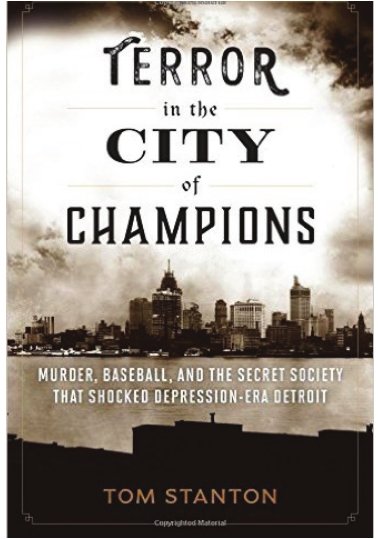
You’ve probably heard of Detroit’s Purple Gang, and have almost certainly heard about the pervasiveness of the Ku Klux Klan in Detroit during the 1920s. But just as the Klan was being ushered out, an even more dangerous and insidious gang, the Black Legion, was emerging in the Motor City.
“The Black Legion was a different animal and a lot more dangerous.” said Tom Stanton, author of “Terror in the City of Champions: Murder, Baseball and the Secret Society that Shocked Depression-era Detroit.”
“The Legion had a lot of high ranking folks involved,” he added. “They liked to say they had friends in high places.”
The Black Legion maintained the secrecy of its membership through threat of death to anyone who revealed the identity of members. Legion members who missed meetings could be flogged. Like the Klan, the Black Legion had a structured military hierarchy. Members wore regalia that included black robes decorated with a skull and crossbones and a cap reminiscent of a pirate’s hat. The group also had secret passwords and gestures to identify themselves to each other.
“The Legion came out of the ashes of the Klan and had some of the same elements,” Stanton said.
The Black Legion was similar to the Klan in that both organizations hated blacks, Jews, immigrants and Catholics. The group was also adamantly opposed to emerging trade unions and, of course, communist and leftist groups.
A majority of Black Legion members were from the South and were politically conservative. All were white and Protestant. Estimates of the size of the Black Legion, which primarily operated in the Midwest, range anywhere from tens of thousands to 6 million. Stanton believes that the membership was closer to 100,000 but maybe as low as 30,000.
One of the group’s leaders, Virgil “Bert” Effinger, often claimed that the Black Legion had more members than were needed to start the Russian Revolution. Members were recruited under threat of death. Even those who didn’t want to be involved were still counted as members.
As the Black Legion was rising, so were Detroit’s sports teams. Stanton, who has written four nonfiction books on baseball, pairs the story of the Black Legion’s rise with the Detroit Tigers’ run to the pennant in 1935 under the leadership of player/coach Mickey Cochrane. He alternates chapters between the Black Legion and the Tigers, building tension as he goes.
As the Tigers won the World Series against the Cubs, the Black Legion was reaching its own apex. In May, members of the group murdered a Catholic Detroiter, Charles Poole, who allegedly beat his wife. Poole was taken to a field and shot by a group of Black Legion members.
One of those members, Dayton Dean, broke the code of secrecy and confessed to the murder, implicating nearly a dozen other Black Legion members. He also told the authorities about other murders and attempted assassinations. Dean, along with 11 others, was convicted of murder and sent to prison for life. Ultimately, nearly 50 Legion members were convicted of crimes based on Dean’s testimony.
The Black Legion quickly dissipated — and so did the Detroit Tigers and Mickey Cochrane, who limped along after the 1935 season. But 1935 and 1936 proved to be a golden era for Detroit sports, with the Tigers, Red Wings and Lions all winning league championships. The Tigers wouldn’t win a World Series again until 1945. The Lions would have to wait until the 1950s for another championship season and have not won a championship since the inception of the Super Bowl in 1967.
Looking back on it, Stanton is amazed at the secrecy of the Black Legion.
“People actually wondered, ‘Is my neighbor a member? Is my husband a member?’” he said.
Black Legion members included a Detroit Police commissioner, Detroit Police officers, and Jackson Prison guards. Members of the group were often arrested but rarely charged with crimes.
Stanton said there is circumstantial evidence that Henry Ford’s enforcer, Harry Bennett, was a member of the Black Legion, but there is no smoking gun. Bennett often took advantage of groups that could help him, so it would not have been unusual for him to have forged an alliance with the Black Legion. There was at least one murder at Ford’s factory that was attributed to the group.
“The Legion was a massive thing when (the murder) happened, but it was put to bed after Roosevelt was swept into office in 1936,” Stanton said. “A huge deal had faded away into history.”
Tom Stanton
Author talk and book signing 7 p.m. Tuesday, June 14 FREE Schuler Books & Music (Meridian Mall location) 1982 W. Grand River Ave., Okemos (517) 349-8840, schulerbooks.com
Support City Pulse - Donate Today!
Comments
No comments on this item Please log in to comment by clicking here